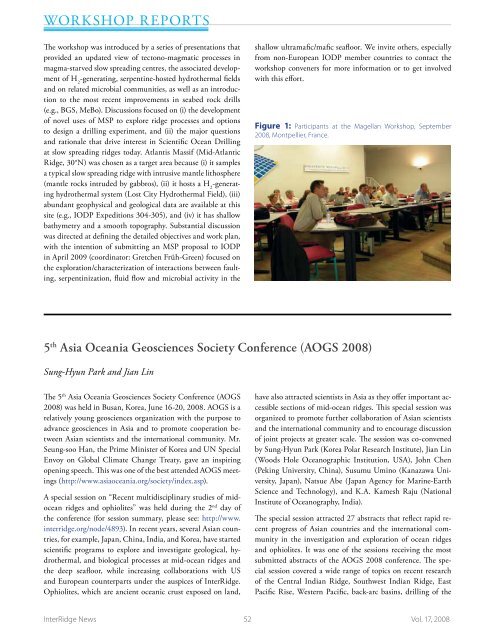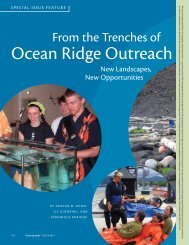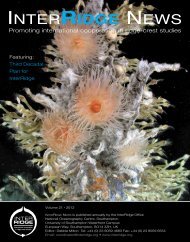Full version, lower resolution, 3.25MB - InterRidge
Full version, lower resolution, 3.25MB - InterRidge
Full version, lower resolution, 3.25MB - InterRidge
You also want an ePaper? Increase the reach of your titles
YUMPU automatically turns print PDFs into web optimized ePapers that Google loves.
Workshop Reports<br />
The workshop was introduced by a series of presentations that<br />
provided an updated view of tectono-magmatic processes in<br />
magma-starved slow spreading centres, the associated development<br />
of H 2<br />
-generating, serpentine-hosted hydrothermal fields<br />
and on related microbial communities, as well as an introduction<br />
to the most recent improvements in seabed rock drills<br />
(e.g., BGS, MeBo). Discussions focused on (i) the development<br />
of novel uses of MSP to explore ridge processes and options<br />
to design a drilling experiment, and (ii) the major questions<br />
and rationale that drive interest in Scientific Ocean Drilling<br />
at slow spreading ridges today. Atlantis Massif (Mid-Atlantic<br />
Ridge, 30°N) was chosen as a target area because (i) it samples<br />
a typical slow spreading ridge with intrusive mantle lithosphere<br />
(mantle rocks intruded by gabbros), (ii) it hosts a H 2<br />
-generating<br />
hydrothermal system (Lost City Hydrothermal Field), (iii)<br />
abundant geophysical and geological data are available at this<br />
site (e.g., IODP Expeditions 304-305), and (iv) it has shallow<br />
bathymetry and a smooth topography. Substantial discussion<br />
was directed at defining the detailed objectives and work plan,<br />
with the intention of submitting an MSP proposal to IODP<br />
in April 2009 (coordinator: Gretchen Früh-Green) focused on<br />
the exploration/characterization of interactions between faulting,<br />
serpentinization, fluid flow and microbial activity in the<br />
shallow ultramafic/mafic seafloor. We invite others, especially<br />
from non-European IODP member countries to contact the<br />
workshop conveners for more information or to get involved<br />
with this effort.<br />
Figure 1: Participants at the Magellan Workshop, September<br />
2008, Montpellier, France.<br />
5 th Asia Oceania Geosciences Society Conference (AOGS 2008)<br />
Sung-Hyun Park and Jian Lin<br />
The 5 th Asia Oceania Geosciences Society Conference (AOGS<br />
2008) was held in Busan, Korea, June 16-20, 2008. AOGS is a<br />
relatively young geosciences organization with the purpose to<br />
advance geosciences in Asia and to promote cooperation between<br />
Asian scientists and the international community. Mr.<br />
Seung-soo Han, the Prime Minister of Korea and UN Special<br />
Envoy on Global Climate Change Treaty, gave an inspiring<br />
opening speech. This was one of the best attended AOGS meetings<br />
(http://www.asiaoceania.org/society/index.asp).<br />
A special session on “Recent multidisciplinary studies of midocean<br />
ridges and ophiolites” was held during the 2 nd day of<br />
the conference (for session summary, please see: http://www.<br />
interridge.org/node/4893). In recent years, several Asian countries,<br />
for example, Japan, China, India, and Korea, have started<br />
scientific programs to explore and investigate geological, hydrothermal,<br />
and biological processes at mid-ocean ridges and<br />
the deep seafloor, while increasing collaborations with US<br />
and European counterparts under the auspices of <strong>InterRidge</strong>.<br />
Ophiolites, which are ancient oceanic crust exposed on land,<br />
have also attracted scientists in Asia as they offer important accessible<br />
sections of mid-ocean ridges. This special session was<br />
organized to promote further collaboration of Asian scientists<br />
and the international community and to encourage discussion<br />
of joint projects at greater scale. The session was co-convened<br />
by Sung-Hyun Park (Korea Polar Research Institute), Jian Lin<br />
(Woods Hole Oceanographic Institution, USA), John Chen<br />
(Peking University, China), Susumu Umino (Kanazawa University,<br />
Japan), Natsue Abe (Japan Agency for Marine-Earth<br />
Science and Technology), and K.A. Kamesh Raju (National<br />
Institute of Oceanography, India).<br />
The special session attracted 27 abstracts that reflect rapid recent<br />
progress of Asian countries and the international community<br />
in the investigation and exploration of ocean ridges<br />
and ophiolites. It was one of the sessions receiving the most<br />
submitted abstracts of the AOGS 2008 conference. The special<br />
session covered a wide range of topics on recent research<br />
of the Central Indian Ridge, Southwest Indian Ridge, East<br />
Pacific Rise, Western Pacific, back-arc basins, drilling of the<br />
<strong>InterRidge</strong> News 52 Vol. 17, 2008
















